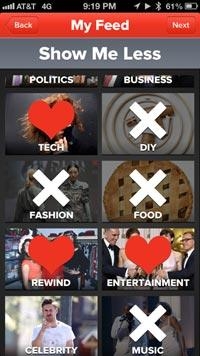 BuzzFeed has never shied away from the odd consequences of a news organization driven fundamentally by social media. Everything from the way it reads trends in order to
identify story topics, to the cute icons readers use to tag stories, and to its wildly successful distribution system makes the crowd the driving force behind the news that appears and how it is fed
into people’s browsers and apps. And as the site beefs up its own staff of news writers and investigative journalists, the mix becomes stranger and stranger. The feed starts to look like a
randomized montage of topics, from the signature cute animal slideshows to the political scandal scoops the site has landed in recent months.
BuzzFeed has never shied away from the odd consequences of a news organization driven fundamentally by social media. Everything from the way it reads trends in order to
identify story topics, to the cute icons readers use to tag stories, and to its wildly successful distribution system makes the crowd the driving force behind the news that appears and how it is fed
into people’s browsers and apps. And as the site beefs up its own staff of news writers and investigative journalists, the mix becomes stranger and stranger. The feed starts to look like a
randomized montage of topics, from the signature cute animal slideshows to the political scandal scoops the site has landed in recent months.
The argument that I have heard BuzzFeed
executives make about this strange brew is that the younger demographic this company serves is already used to receiving its news as such a strange collection of the serious and the frivolous in their
own social media feeds. The juxtapositions that may make old news geek farts like me wince in wonderment are simply unremarkable to those for whom the feed is the native content format.
advertisement
advertisement
It is
an interesting and provocative argument, but late last week BuzzFeed seemed to acknowledge that the default mode isn’t right for everyone. In a major upgrade to its mobile app, BuzzFeed now
allows users to personalize the feed by signaling which topics they want to see more of and which to see less of. The app makes personalization as easy as applying tags.
On first launch the
app invites you to tap on a wall of tiles to designate which of nearly a dozen topics you want to see more often, including politics, business, tech, DIY, and of course animals. The subsequent wall
lets you designate which topic to see fewer stories about. It is a simple but wholly effective way to give the user a sense of control, particularly being able to vote on what you want to see less of
not just more of. That it labels these choices as 'less' or 'more' also suggests that the feed retains some of its own editorial curation function apart from the user. In fact, this has been one of
the big questions about personalization over the many years that I have covered it in digital media.
I’ve watched many companies over the years try to manage appealing to users’
desire to control the news mix against maintaining editorial authority. There is no ideal balance probably, but it does seem to be important to let the user know who was driving what part of the news.
The app lets you choose between the default BuzzFeed curation and a My Feed version. This seems a decent compromise.
The role of personalization in mobile media is going to be one of the
important next steps I believe. As in so many things, the constraints and intimacy of personal devices forces some issues that have been simply floating around the digital ecosystem for over a decade.
Now we need to start thinking harder about how to balance personal control against editorial identity as well as the need to maintain some element of serendipity and random discovery.